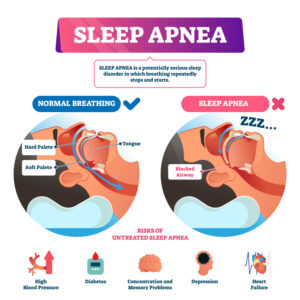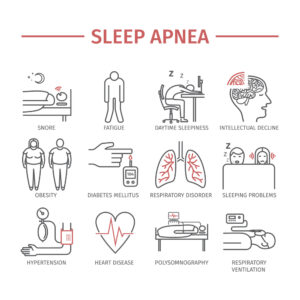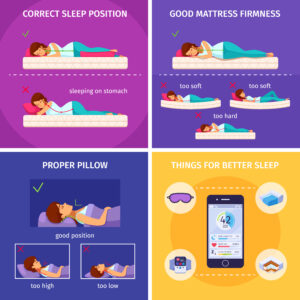Sleep Apnea
Sleep apnea is a sleep disorder characterized by repeated interruptions in breathing during sleep. These interruptions, called apneas, can last for several seconds to minutes and may occur numerous times throughout the night. There are two main types of sleep apnea:

1. Obstructive Sleep Apnea (OSA): This is the most common form of sleep apnea. It occurs when the muscles at the back of the throat fail to keep the airway open, leading to a blockage or narrowing of the airway during sleep.
2. Central Sleep Apnea: This type is less common and happens when the brain fails to send the appropriate signals to the muscles responsible for controlling breathing during sleep.
Some common symptoms of sleep apnea include loud snoring, gasping or choking during sleep, daytime sleepiness or fatigue, difficulty concentrating, morning headaches, and irritability.

Management of sleep apnea typically involves the following approaches:
1. Continuous Positive Airway Pressure (CPAP): CPAP therapy is the most common and effective treatment for obstructive sleep apnea. It involves wearing a mask connected to a machine that delivers a continuous flow of air pressure to keep the airway open during sleep.
2. Bi-level Positive Airway Pressure (BiPAP): This therapy is similar to CPAP but provides two different air pressure levels: higher pressure during inhalation and lower pressure during exhalation. It may be prescribed for people who find it difficult to exhale against the continuous pressure of CPAP.

3. Adaptive Servo-Ventilation (ASV): ASV devices adjust the air pressure based on the person's breathing pattern, helping to maintain a stable breathing pattern during sleep. It's commonly used for central sleep apnea and certain types of complex sleep apnea.
4. Oral Appliances: For mild to moderate sleep apnea or in cases where CPAP is not well-tolerated, oral appliances (e.g., mandibular advancement devices) may be used. These devices help reposition the jaw and tongue to keep the airway open.
5. Lifestyle Changes: Certain lifestyle modifications can help improve sleep apnea symptoms. These include losing weight (if overweight or obese), avoiding alcohol and sedatives before bedtime, sleeping on your side instead of your back, and maintaining a regular sleep schedule.
6. Surgery: In some cases, surgical procedures may be considered to remove excess tissue in the throat or correct structural issues that contribute to sleep apnea. Surgery is usually considered when other treatments have not been successful.

It's crucial to get a proper diagnosis and treatment plan from a sleep specialist or pulmonologist if you suspect you or someone you know may have sleep apnea. Untreated sleep apnea can lead to serious health complications, including cardiovascular problems, daytime fatigue-related accidents, and decreased overall quality of life.

